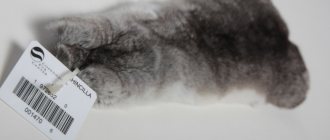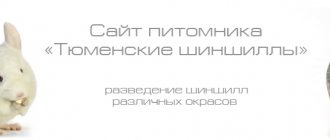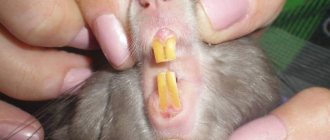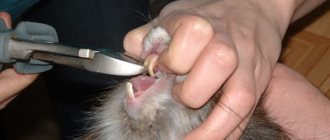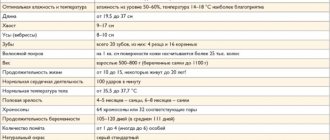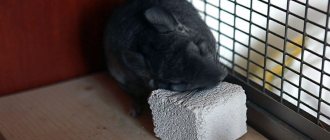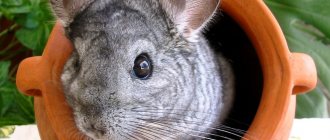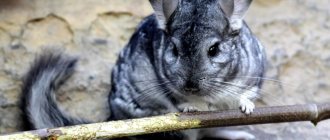Malocclusion in chinchillas: causes, symptoms, prevention.
Rodent teeth have one characteristic feature - they grow throughout the animal’s life. And this, especially if the animal is domestic, can cause him a lot of inconvenience, and in especially severe cases even lead to his death!
What do you need to know about the teeth of your favorite rodent? Chinchillas have a relatively small and narrow oral cavity, but with well-developed gums. Adult animals have only 20 teeth - 4 incisors and 16 molars. The molars are set deeply in the jaw bones. Newborn animals have 8 molars and 4 incisors. Incisors grow throughout the life of animals.
Malocclusion in chinchillas: reasons
The most unpleasant dental problem in chinchillas may be malocclusion - incorrect positioning of the teeth and, accordingly, improper contact between the surfaces of the incisors or chewing teeth. Incisors are real record holders when it comes to growth, but this is a dubious achievement. Overgrown teeth interfere with each other, injure the gums, and cannot chew food properly.
The causes of malocclusion can be different:
- genetic predisposition
- jaw injuries
- metabolic disorders
- presence of systemic disease
- tooth prick
- and even parasitic infections and some skin diseases that reduce appetite.
But it is believed that the most common cause of malocclusion is errors in the care and feeding of the chinchilla. Thus, high-quality ready-made dry food is an excellent, well-balanced food for rodents. But we should not forget that these animals need hay every day, as well as grass and dried plant branches so that they can fully chew and grind down their wild teeth.
Symptoms of malocclusion
Watch the animal's appetite and how it eats.
The first symptoms of malocclusion are:
- the animal refuses hard food
- eyes are streaming
- constantly rubs his face with his paw
- bites and throws food
- pulls the mouth while eating (as when vomiting).
If your pet is sad, has lost his appetite and is reluctant to chew food, it may simply be painful for him to do so! Profuse salivation may begin, the fur becomes wet, which means that the reason is that the teeth have damaged the mucous membrane and it is also very unpleasant for the chinchilla to swallow. And since the roots of the upper teeth have a direct anatomical connection with the eyeballs and tear ducts, sometimes the animal literally cries in pain! An animal can sit over food because it wants to eat, but it cannot do it; sometimes it tries to take food into its mouth, but it falls out.
If you notice anything even remotely similar to these signs, immediately contact a veterinarian, preferably a ratologist - a specialist in the treatment of rodents. The effect in the future depends on timely treatment of malocclusion in chinchillas. The sooner measures are taken, the greater the chance of restoring the bite. Delay here is like death: the animal will eventually simply refuse food and die from exhaustion. As the disease progresses, it becomes increasingly difficult for the animal to chew food - it begins to eat only soft food, and then may stop eating altogether.
Symptoms of malocclusion
1. The first sign is that the chinchilla becomes “picky” in food. The animal sits at the bowl for a long time, chooses softer food, digs around, and scatters the food. The chinchilla rubs its cheeks with its paws, reduces motor activity, and sometimes sits down for a long time. If you notice changes in eating behavior, start monitoring your pet's weight. Constant weight loss, even small, by 1-2-3 grams per day, is a signal. For an adult chinchilla, losing 10 grams of weight per day is already critical. If you do not observe any digestive problems, then the likely cause is teeth.
Prevention of malocclusion
In most cases, it is much easier to prevent the development of malocclusion than to treat it. The main preventive measures are proper nutrition for the pet (granulate, stones, twigs - for grinding constantly growing teeth).
Chinchillas need high-quality hay every day: firstly, it is an excellent source of fiber, and secondly, it plays a big role in grinding down the molars.
Granulate is good for grinding teeth, but it is not an alternative to the natural diet of rodents. Therefore, for the best grinding, you should regularly give the animal suitable material for gnawing - twigs of ash, maple, birch, elm, apple, pear, alder, currant, blackberry. A chinchilla's cage must also have a sharpening stone, a mineral stone, and various wooden toys.
In order to prevent the development of oral diseases, it is very important to visit a veterinarian annually (or even better, once every six months).
Common dental problems in chinchillas.
Chinchillas are exotic rodents whose teeth grow throughout their lives. In case of improper tooth wear, regular teeth grinding is used in chinchillas, thanks to which the animal can eat well and live actively. Many owners naively believe that exotic animals have only two pairs of orange incisors. In fact, in the oral cavity of rodents there are 20 teeth: 4 incisors and 16 cheek teeth, which actively grow from birth to death of the animal.
Dental problems in chinchillas negatively affect the health of furry pets; the animals refuse to eat and rapidly lose weight. In the absence of timely contact with a specialist, the death of your beloved animals is possible. Trimming your teeth yourself at home using a makeshift method is highly not recommended.
Dental grinding surgery is performed by a veterinarian in a clinic using painkillers.
Looking at the chinchilla skull, you can see the presence of not only the front incisors
Symptoms of dental pathologies in chinchillas
You can suspect that your pet has dental problems based on a number of characteristic symptoms:
- the animal spends a long time sorting through food, scatters food, tries to eat only soft food, refuses hay, sometimes there is a complete refusal of food;
- the animal often rubs its cheeks, yawns, does not eat, sits with its mouth open;
- profuse drooling, wet fur on the face and forelimbs;
- swelling of the jaws;
- reduction of droppings until their complete disappearance, sometimes softening of feces, diarrhea;
- rapid weight loss;
- mucous discharge from the nose and eyes;
- long protruding incisors;
- fistulas on the cheeks.
The initial stages of diseases most often go unnoticed. When the clinical picture of the pathology appears, the disease is in an advanced state. Along with dental problems, chinchillas experience disturbances in the functioning of the gastrointestinal tract and liver.
Critical weight loss can be fatal for your pet.
Oral examinations should be performed regularly by a veterinarian.
Ingrown tooth roots
A fairly common pathology is ingrowth or elongation of roots; this problem can develop equally on both jaws. If the ingrowth occurs in the upper jaw, the sinuses and eyes may suffer. If the problem began in the lower jaw, then swelling of the entire jaw is noted.
This disease has a number of characteristic signs:
- painful sensations;
- loss of appetite;
- weight loss;
- development of conjunctivitis and nasal discharge;
- abscess on the face.
This pathology is considered very rare and can only be detected using x-rays. This disease has no cure.
Causes of dental pathologies in chinchillas
Dental problems in rodents can be due to a number of reasons:
- unbalanced diet, predominant feeding of soft foods, lack of mineral stone and twig food, which lead to insufficient tooth wear;
- hereditary diseases and congenital abnormalities of the jaw structure;
- injuries resulting in jaw displacement and malocclusion;
- chronic diseases, manifested by prolonged refusal of food and tooth regrowth;
- autoimmune diseases;
- lack of minerals – often in lactating females.
The genetic predisposition of chinchillas to dental pathologies has not been studied; animals with dental problems should not be allowed to breed.
Urolithiasis disease
The development of urolithiasis is fraught with inflammation of the bladder in a small chinchilla. This disease is typical for adult males.
Symptoms : the rodent begins to behave inappropriately, problems with normal urination begin. To detect pathology in a timely manner, it is advisable to take your pet to a veterinarian, who will perform a urine test and, if necessary, conduct an ultrasound examination of the bladder and kidneys.
Treatment : if there is sand in the organs, specific therapy is prescribed, but if there are stones in the genitourinary system, their surgical removal will be required.
Types of dental diseases in chinchillas
Depending on the clinical manifestation, the following types of dental pathologies in chinchillas are distinguished.
Malocclusion
Malocclusion in a chinchilla is characterized by a malocclusion due to the formation of pathological processes - hooks - on the animal's teeth. The furry rodent's jaws do not close. The small animal is not able to eat fully. The pathology is characterized by:
- profuse drooling;
- rapid weight loss.
In advanced stages of the disease, stomatitis develops in chinchillas:
- the edges of the cheeks and tongue are injured by the sharp edges of overgrown tooth crowns;
- In the animal’s oral cavity, inflammation of the mucous membrane is observed with the formation of bleeding ulcers and fistulas on the cheeks of the pet.
Teeth that are too long are a pathology requiring veterinary help.
Crown regrowth
If teeth wear is disrupted, pathological elongation of clinical crowns occurs, accompanied by malocclusion, drooling and inability to eat.
Ingrown tooth roots
The roots of teeth in chinchillas mean the reserve or subgingival part of the crown, which can grow into soft tissues, affecting the eyes or sinuses. The pathology is accompanied by:
- severe pain;
- refusal of food;
- progressive emaciation;
- symptoms of conjunctivitis and rhinitis;
- the formation of dense swellings on the animal’s jaws and facial abscesses.
An abscess on a chinchilla's cheek is a sign of dental disease.
Tooth loss
If a chinchilla's tooth has fallen out, it is necessary to treat the oral cavity with an anti-inflammatory gel and consult a specialist. The cause of tooth loss can be trauma, stomatitis, or pathological regrowth of crowns.
Ear disease
Due to severe pollution, chinchillas may develop an inflammatory process in the external auditory canals. Sick animals begin to scratch their ears and rub their heads against the corners of the cage. In advanced forms of inflammation, they constantly keep their head tilted to one side. Visually, you can notice a large amount of brown pus leaking from their ears, which in turn can cause inflammation of the skin around the affected ear.
Ear disease
Treatment : to treat ear inflammation, you need to drip antibacterial drops into the ear canals.
How to trim chinchillas' teeth
Any manifestation of dental pathology requires immediate contact to a veterinary clinic. Diagnosis of dental pathologies includes:
- examination of the animal’s oral cavity with a veterinary otoscope using gas anesthesia;
- X-ray examination;
- computed tomography or video stomatoscopy.
Examination of the chinchilla's oral cavity by a veterinarian.
Surgical treatment of dental diseases in rodents is carried out by a veterinary specialist in an operating room using local gas anesthesia.
The veterinarian can use an otoscope to check the condition of the cheek teeth.
In order to carefully grind down a chinchilla’s teeth without damaging the oral mucosa, the rodentologist must secure the animal in a special machine.
Fixing a rodent in a pen
The operation of grinding teeth is carried out using dental equipment using mechanical grinding. When crowns re-grow with the formation of hooks, it is recommended to trim the teeth once every 3-4 months using laser grinding.
The cost of the operation is 1500-3000 rubles.
In advanced cases, it is sometimes necessary to remove the chinchilla's teeth. A similar procedure should also be carried out by rodentologists in a veterinary clinic.
After the teeth grinding procedure, the pet owner must provide postoperative care:
- treating the animal’s oral cavity with antiseptic solutions and herbal decoctions;
- use of painkillers;
- in the absence of appetite - feeding pasty food from a syringe;
- examination by a specialist.
After recovery, it is recommended to review the furry animal’s diet. The chinchilla needs to be given large quantities of hay and roughage to physiologically wear down the teeth.
Why does a chinchilla grind his teeth?
If a domestic chinchilla grinds its teeth with a good appetite and activity, then the grinding is the sound of the animal’s molars grinding down and is a physiological phenomenon. Some pets grind their teeth even in their sleep.
If a furry rodent creaks or chatters its teeth in the absence of appetite, there is diarrhea, paralysis of the limbs, and excessive drooling, it is recommended to urgently contact a specialist to save the animal’s life. Such a grinding noise may be a symptom of poisoning of a pet animal.
Dental pathologies cause severe discomfort to chinchillas. To prevent dental problems, it is necessary to properly feed unusual animals and use special mineral stones to grind down teeth. Treatment of dental diseases should be carried out by experienced specialists only in a veterinary clinic to avoid causing injury to furry pets.
The sooner the pet owner contacts a veterinarian if a chinchilla has dental problems, the greater the chances of successful treatment and prolonging the life of his little friend.
Therapy in cases to be treated
Any deviation from the norm in the condition of the teeth of these animals is a reason to urgently consult a veterinarian. When examined by a doctor, your pet will undergo diagnostic procedures:
- visual examination of the mouth using gas anesthesia;
- visit to the radiologist's booth;
- tomography using a computer.
If the initial examination shows that the animal is unhealthy, it will undergo surgical intervention in a veterinary surgical office. There the animal's jaw will be polished mechanically.
How many teeth does a chinchilla have, features of their structure
Many chinchilla owners do not know how many teeth their pet has. Only the front teeth are visible, which can be seen by moving the animal’s lip away. In fact, rodents have 20 teeth:
- 4 incisors, two on top and bottom. Length varies from 0.6 to 1.2 cm;
- The 16 molars located deeper in the mouth are:
- 4 premolars - small teeth, one each on the right and left on the upper and lower jaw;
- 12 molars are large teeth, three on the right and left on the upper and lower jaw.
What do chinchilla teeth look like?
Molars have a wide, ribbed chewing surface. They are located deep in the jaw. The entire length of the teeth together with the root is approximately 1.2 cm (root - 0.9 cm, crown height - 0.3 cm). Small individuals are born with 4 incisors and 8 cheek teeth. Chinchillas do not have fangs. The toothless area from the incisors to the molars is empty and is called a diastema.
The animals' front incisors range in color from dark yellow to orange. The back part is devoid of enamel, so they are easily erased. If for some reason grinding does not occur, the teeth grow long and create discomfort for the animal.
Causes of dental pathologies
Dental problems in chinchillas negatively affect their health. Animals refuse food, which leads to rapid weight loss. Failure to contact a specialist in a timely manner can lead to the death of your pet. Never trim your teeth yourself. This procedure should only be performed by a veterinarian in a specialized clinic or veterinary office.
Dental problems in chinchillas can occur for many reasons:
- heredity or congenital anomaly;
- poor, unbalanced diet, lack of solid foods;
- injury, due to which the teeth have shifted, an incorrect bite and poor abrasion have appeared;
- diseases that lead to food refusal;
- lack of minerals. It is more often observed in females during the feeding period.
Chinchilla teeth misalignment
Animals with genetic abnormalities are “weeded out” and are not allowed to reproduce further.
Dental problems
Chinchillas sometimes have dental problems, the reasons are due to:
Animals that have genetic defects in their teeth do not always cause problems for their owner. Very often, chinchillas with white teeth live without problems and live the same long lives as their brothers. But there are also cases when a chinchilla is very much more than that and you have to very often monitor it and the condition of its teeth. In this case, you will have to spend a lot of time and sometimes money to ensure that your pet grows up healthy. Therefore, it is better to make sure that the animal is completely healthy before purchasing.
HOWEVER, such individuals do not participate in mating, so that bad genes are not passed on to the next generation. They are usually recommended to be kept alone in a cage.
From poor nutrition , even healthy individuals will have dental problems.
In order for teeth to grow correctly, it is necessary that the chinchilla’s diet include:
If the diet is correct, then the chinchilla will grind down its teeth while eating and will not need any additional care or treatment. Make sure that your chinchilla always has something to chew in his cage and that there is enough calcium in his food.
A fairly rare occurrence, but sometimes chinchillas get injured from falls and bruises. Most often this happens to owners who let their chinchillas roam unattended.
After receiving an injury, the jaw may shift or the bite may be disrupted and the incisors will begin to grow incorrectly, because the chinchilla will not be able to grind them down. In this case, there should be no home treatment; immediately take it to the veterinarian so that he can correct everything and prescribe treatment.
In rare cases, the incisors may break, but here everything can be solved by simply grinding them down, then the incisors will grow back on their own and there will be no more problems.
Types of dental pathologies in chinchillas
Signs that your pet has dental problems include constantly wet fur around the mouth and underneath. In this case, you need to contact a specialist and clarify the cause of the disease, as well as what kind of disease has affected the animal. Dental problems in chinchillas are divided into types, depending on the clinical picture.
Malocclusion
Malocclusion, or as it is also called hooks on the teeth, appears as a result of malocclusion, poor closure of teeth caused by insufficient abrasion. This happens for a number of reasons:
- poor nutrition;
- imbalance of minerals in the body;
- autoimmune processes;
- jaw injuries;
- heredity.
The first symptoms of malocclusion are the animal's refusal to eat and severe weight loss. After observing your pet, you will notice that he does not immediately begin to eat, twists the food in his paws, and chooses the smallest and softest pieces from the food. Further development of the disease is characterized by tearing of the eyes and movement of the mouth, as during vomiting. Signs of an advanced form are increased salivation, softening of the stool, and stomatitis. Inflammation in the oral cavity with bleeding wounds is the result of regular injury to the tongue on the sharp edges of overgrown teeth. Lack of medical intervention leads to complete refusal of food.
Trimming chinchilla teeth
After teeth trimming, your pet may need help eating. If the animal has lost significant weight, feed it porridge from ground food through a syringe. In the future, the animal will understand that there is no more discomfort and will begin to feed on its own.
Crown regrowth
Teeth grinding occurs when a chinchilla chews hard food or grinds them. If natural abrasion does not occur, the crowns of the teeth begin to grow back, which leads to major health problems: the correct bite is disrupted, drooling appears and refusal to eat with all that it entails.
Ingrown tooth roots
Root elongation (ingrowth of roots into the jaw) occurs in both the upper and lower jaw. Depending on where the pathology occurs, the eyes or sinuses are affected. If the roots of the lower teeth have elongated, this manifests itself in the form of swelling along the jaw. Elongation of the roots of the upper teeth is characterized by protruding eyes as a result of pressure on them, as well as the occurrence of infections. The disease has associated unpleasant manifestations:
- soreness;
- refusal of food;
- severe weight loss;
- symptoms of conjunctivitis and rhinitis;
- facial abscess.
Ingrown teeth are extremely rare. The problem can be identified by x-ray examination. The pathology cannot be treated.
Features and methods of treatment
Any deviation of the teeth from the norm in chinchillas requires immediate medical examination and treatment. The veterinarian carries out a number of diagnostic measures, including:
- examination of the animal’s oral cavity with an otoscope under gas anesthesia;
- X-ray;
- CT scan.
Dental X-ray - a method for diagnosing chinchilla teeth
Surgery is performed in a specially equipped operating room. The animal is fixed on the machine so that the doctor does not injure its oral mucosa while grinding down its teeth. The procedure is performed by mechanical grinding. Dental removal is also performed in a veterinarian's office under local anesthesia.
Any medical intervention requires proper postoperative care. This includes daily treatment of the oral cavity with an antiseptic or herbal decoction. Painful conditions are eliminated with painkillers. During the first days, it is possible to feed the chinchilla via a syringe. It is also recommended to be examined by a specialist to exclude side effects.
Constipation
This disease is typical for young individuals, males or pregnant females. In many cases, it ends in death or rupture of the intestinal walls. The development of constipation in a chinchilla can be provoked by infection, the presence of a large amount of concentrated food in the diet, lack of drinking water, stress, and lack of space for movement.
Signs : if a rodent has not had a bowel movement for several days, constantly sits in a corner, is hunched over, or climbs on the walls, this means that it is constipated, and in most cases in the cecum. If you lightly palpate the abdomen, you can feel the place where feces have accumulated.
Treatment : with timely diagnosis, constipation can be cured by introducing succulent green foods, juices and fruits that contain a lot of fluid into the diet. If constipation is more severe, you can try injecting paraffin oil into the rectum and mouth. This oil will help improve the passage of stool through the intestines.
Why does a chinchilla grind his teeth?
Surely many chinchilla owners have noticed that from time to time the animal grinds or chatters its teeth. Why does a chinchilla grind its teeth? There are two options for this behavior. If the animal has a good appetite and is active, it means that the physiological process of natural grinding of teeth is occurring. But if a chinchilla is chattering its teeth and there is a lack of appetite, paralysis of the limbs, and drooling, then you should immediately consult a doctor. This behavior may be a sign of food poisoning.
